-
 Bitcoin
Bitcoin $118400
0.47% -
 Ethereum
Ethereum $3836
2.20% -
 XRP
XRP $3.157
2.98% -
 Tether USDt
Tether USDt $0.9999
-0.03% -
 BNB
BNB $801.5
1.31% -
 Solana
Solana $180.9
2.07% -
 USDC
USDC $0.9999
-0.02% -
 Dogecoin
Dogecoin $0.2225
2.50% -
 TRON
TRON $0.3285
-1.02% -
 Cardano
Cardano $0.7789
2.60% -
 Hyperliquid
Hyperliquid $43.60
2.39% -
 Sui
Sui $3.892
4.41% -
 Stellar
Stellar $0.4229
3.34% -
 Chainlink
Chainlink $18.01
3.98% -
 Hedera
Hedera $0.2745
6.77% -
 Bitcoin Cash
Bitcoin Cash $582.3
3.38% -
 Avalanche
Avalanche $23.77
1.04% -
 Ethena USDe
Ethena USDe $1.001
0.01% -
 Toncoin
Toncoin $3.493
3.59% -
 Litecoin
Litecoin $110.0
2.48% -
 UNUS SED LEO
UNUS SED LEO $8.936
-0.37% -
 Shiba Inu
Shiba Inu $0.00001304
2.49% -
 Uniswap
Uniswap $9.999
1.09% -
 Polkadot
Polkadot $3.897
3.26% -
 Monero
Monero $308.6
-0.83% -
 Dai
Dai $0.9999
-0.01% -
 Bitget Token
Bitget Token $4.504
-0.04% -
 Pepe
Pepe $0.00001154
2.95% -
 Cronos
Cronos $0.1471
3.06% -
 Ethena
Ethena $0.6691
19.53%
MACD water second golden cross + shrinking volume stepping back on the ten-day moving average
The MACD water second golden cross, combined with a pullback to the 10-day MA and shrinking volume, signals strong bullish momentum continuation in crypto markets.
Jul 30, 2025 at 06:14 am
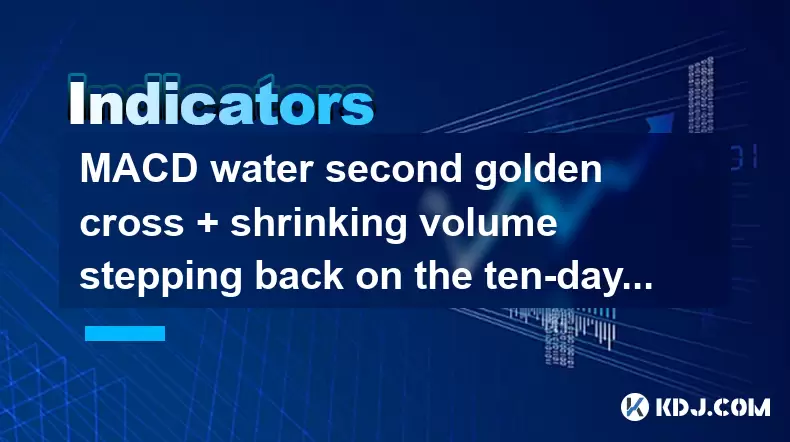
Understanding the MACD Water Second Golden Cross
The MACD (Moving Average Convergence Divergence) is a widely used momentum indicator in technical analysis, particularly within the cryptocurrency trading community. A "water second golden cross" refers to a specific formation where the MACD line crosses above the signal line for the second time after a prior bullish crossover, typically occurring during a pullback in price. This event is considered more reliable than the first golden cross because it confirms sustained momentum after a temporary retracement.
In this context, "water" does not refer to literal water but is a metaphorical term used in Chinese technical analysis circles to describe the second occurrence of a golden cross after a period of consolidation or correction. Traders interpret this as a sign that bears have been exhausted and bulls are regaining control. The setup becomes especially significant when it aligns with other technical indicators such as volume and moving averages.
For cryptocurrency traders, identifying this pattern on a chart involves monitoring the MACD histogram and the relationship between the MACD line and the signal line. When the histogram contracts after a bearish phase and then begins to expand again after the second crossover, it signals renewed upward momentum. This is often seen on 4-hour or daily timeframes in major crypto pairs like BTC/USDT or ETH/USDT.
Role of the Ten-Day Moving Average in Pullback Confirmation
The ten-day moving average (10-day MA) acts as a dynamic support level in short-term trend analysis. When price pulls back to this average and holds, it suggests that the uptrend remains intact. In the scenario described, the stepping back to the ten-day MA indicates a healthy correction rather than a reversal.
To verify this on a chart:
- Ensure the closing price remains above or touches the 10-day MA without closing significantly below it.
- Observe the slope of the 10-day MA — it should still be angled upward, indicating bullish bias.
- Confirm that the candlesticks near the MA show reduced selling pressure, such as small bodies or long lower wicks.
This pullback to the moving average often coincides with profit-taking after a rally. However, when combined with the MACD water second golden cross, it strengthens the case for a continuation of the uptrend. Traders may use this zone as a potential entry point, especially if other indicators align.
Interpreting Shrinking Volume During the Pullback
Volume analysis plays a critical role in validating price movements. Shrinking volume during a pullback suggests weakening selling pressure. In the context of this pattern, declining volume as price approaches the ten-day MA indicates that bears are losing conviction.
To analyze volume effectively:
- Compare the volume bars on the pullback candles to those during the prior uptrend.
- Look for a noticeable reduction in volume on down days, especially near the 10-day MA.
- Confirm that no large sell-off candles appear with high volume near the moving average.
When volume dries up during a correction and price stabilizes, it often precedes a resumption of the trend. In cryptocurrency markets, which are prone to volatility, this can be a key signal that institutional or large traders are accumulating positions quietly. The combination of low volume pullback + MACD second golden cross increases the probability of a bullish breakout.
Step-by-Step Identification of the Full Pattern
To identify this complete technical setup on a cryptocurrency chart, follow these steps:
- Open a trading chart platform such as TradingView or Binance’s built-in charting tool.
- Apply the MACD indicator with default settings (12, 26, 9).
- Overlay the 10-day simple moving average on the price chart.
- Locate a prior golden cross (MACD line crossing above signal line) followed by a price rise.
- Watch for a pullback in price toward the 10-day MA.
- Confirm that during this pullback, volume decreases compared to the previous rally.
- Wait for the MACD line to cross above the signal line a second time.
- Ensure the MACD histogram turns positive and begins expanding.
This sequence must occur in order to qualify as a valid signal. Traders should avoid acting on partial patterns. For example, if volume increases during the pullback, the setup is invalidated. Similarly, if the price closes below the 10-day MA with strong volume, the bullish thesis is compromised.
Execution Strategy for Entry and Risk Management
Once the pattern is confirmed, traders can plan their entries and risk controls. A conservative approach involves waiting for price to close above the high of the candle that triggered the second golden cross.
Entry options include:
- Placing a limit order near the 10-day MA after the MACD crossover, anticipating a bounce.
- Using a market order after confirmation of a strong bullish candle following the crossover.
- Setting a stop-loss below the recent swing low or below the 10-day MA by a small buffer (e.g., 2–3%).
Position sizing should reflect volatility. In high-beta assets like altcoins, smaller position sizes are advisable. For BTC or ETH, traders may allocate more due to higher liquidity. Take-profit levels can be set at prior resistance zones or using a risk-reward ratio of at least 1:2.
It is essential to monitor for false signals, especially in low-liquidity markets or during major news events. Backtesting this strategy on historical data across multiple crypto pairs can improve confidence in its reliability.
Common Misinterpretations and How to Avoid Them
Many traders misidentify the water second golden cross by confusing it with a simple retest of the signal line. The key distinction is that the second crossover must occur after a meaningful pullback, not during continuous uptrend noise.
Avoid these pitfalls:
- Do not act on a second crossover if it happens within the same price zone as the first.
- Reject signals where volume increases during the pullback, indicating strong selling.
- Ignore crossovers that occur when the 10-day MA is flat or sloping downward.
- Be cautious if the MACD histogram fails to expand after the second cross.
Using multiple timeframes can help filter noise. For example, a daily chart signal should align with a bullish structure on the 4-hour chart. Discrepancies between timeframes reduce the signal’s validity.
Frequently Asked Questions
Q: Can the MACD water second golden cross appear in sideways markets?
Yes, it can, but its reliability drops significantly. In ranging markets, MACD crossovers often produce false signals due to lack of directional momentum. The pattern works best in clearly defined uptrends with prior higher highs and higher lows.
Q: How do I adjust the MACD settings for cryptocurrency volatility?
While the default (12, 26, 9) works for most cases, some traders use (8, 17, 9) for faster signals in volatile crypto markets. However, faster settings increase noise. Always test changes in a paper trading environment before live use.
Q: What timeframes are most suitable for spotting this pattern?
The 4-hour and daily charts provide the most reliable signals. Lower timeframes like 15-minute or 1-hour are prone to whipsaws. Higher timeframes reduce false entries but may delay reaction time.
Q: Does this pattern work across all cryptocurrencies?
It performs best on high-liquidity pairs such as BTC/USDT, ETH/USDT, or BNB/USDT. Low-cap altcoins with erratic volume often generate misleading MACD signals due to manipulation and low trading depth.
Disclaimer:info@kdj.com
The information provided is not trading advice. kdj.com does not assume any responsibility for any investments made based on the information provided in this article. Cryptocurrencies are highly volatile and it is highly recommended that you invest with caution after thorough research!
If you believe that the content used on this website infringes your copyright, please contact us immediately (info@kdj.com) and we will delete it promptly.
- Ozak AI: Can This Underdog Crypto Achieve a Bull Run to $1?
- 2025-07-31 22:30:12
- Coinbase Breach: Navigating Insider Risk and Bolstering Security
- 2025-07-31 23:11:55
- Bitcoin Rebounds, WeWake Presale Gains Traction: What's the Buzz?
- 2025-07-31 22:30:12
- Bitcoin, Altcoins, and Volume Watchlists: Decoding the Crypto Landscape
- 2025-07-31 23:11:55
- Tron, Fartcoin, and BlockchainFX: What's Trending (and What's Not) in the Crypto World
- 2025-07-31 21:32:19
- Bitcoin, Corporate Investments, and Sustainability: A New Era or Fleeting Fad?
- 2025-07-31 20:50:14
Related knowledge

How can you use the MACD histogram to determine trend strength?
Jul 31,2025 at 11:10pm
Understanding the MACD Histogram and Its ComponentsThe MACD (Moving Average Convergence Divergence) histogram is a visual representation of the differ...
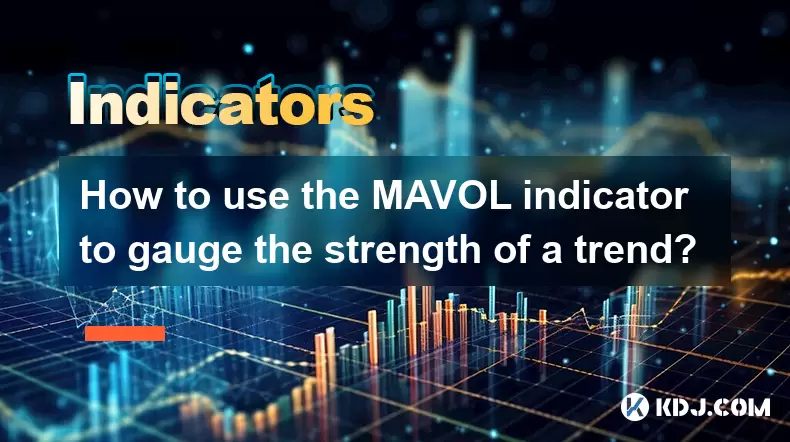
How to use the MAVOL indicator to gauge the strength of a trend?
Jul 31,2025 at 09:57pm
Understanding the MAVOL Indicator in Cryptocurrency TradingThe MAVOL indicator, short for Moving Average of Volume, is a technical analysis tool widel...
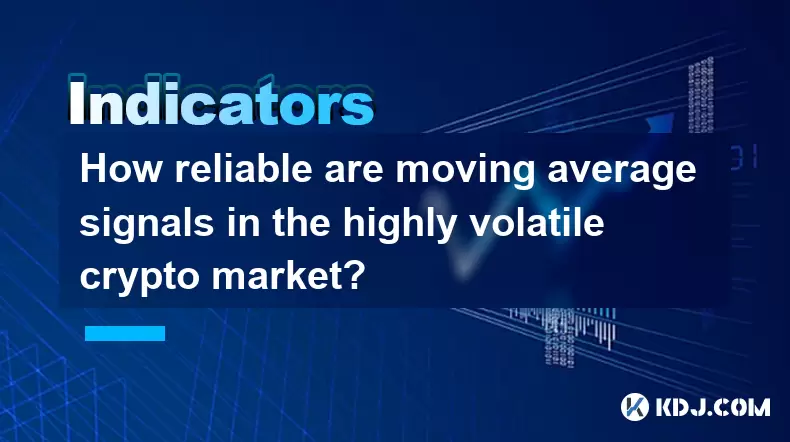
How reliable are moving average signals in the highly volatile crypto market?
Jul 31,2025 at 08:36pm
Understanding Moving Averages in Cryptocurrency TradingMoving averages (MAs) are among the most widely used technical indicators in the cryptocurrency...
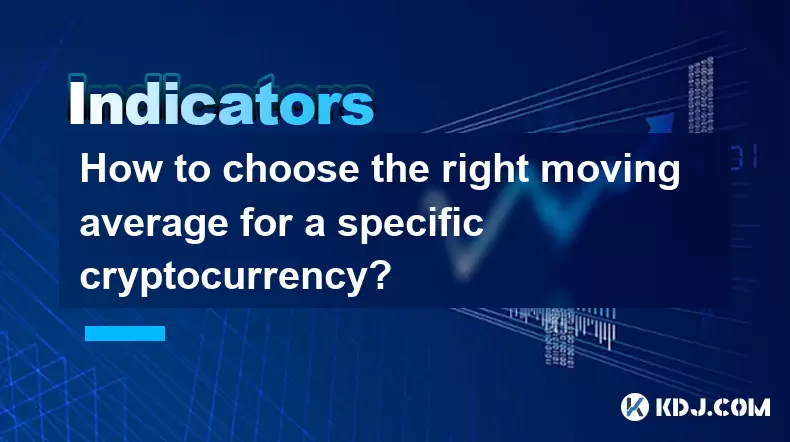
How to choose the right moving average for a specific cryptocurrency?
Jul 31,2025 at 10:29pm
Understanding the Role of Moving Averages in Cryptocurrency TradingMoving averages are foundational tools in technical analysis, widely used by crypto...
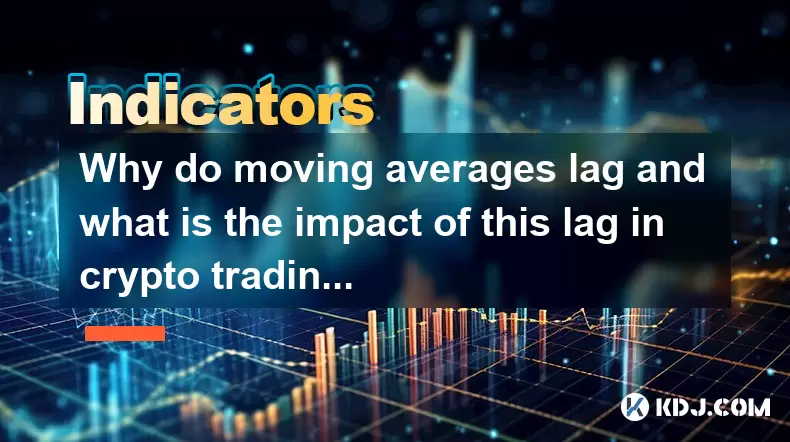
Why do moving averages lag and what is the impact of this lag in crypto trading?
Jul 31,2025 at 08:07pm
Understanding the Concept of Moving Averages in Crypto TradingMoving averages are among the most widely used technical indicators in cryptocurrency tr...
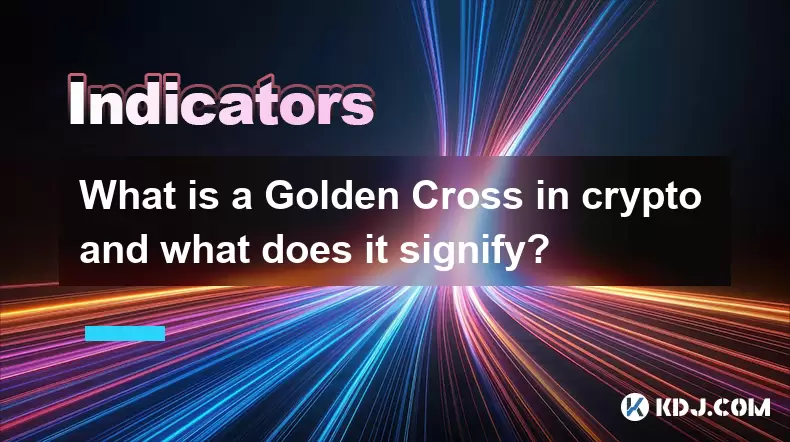
What is a Golden Cross in crypto and what does it signify?
Jul 31,2025 at 10:36pm
Understanding the Golden Cross in Cryptocurrency MarketsThe Golden Cross is a technical analysis pattern widely observed in cryptocurrency trading. It...

How can you use the MACD histogram to determine trend strength?
Jul 31,2025 at 11:10pm
Understanding the MACD Histogram and Its ComponentsThe MACD (Moving Average Convergence Divergence) histogram is a visual representation of the differ...

How to use the MAVOL indicator to gauge the strength of a trend?
Jul 31,2025 at 09:57pm
Understanding the MAVOL Indicator in Cryptocurrency TradingThe MAVOL indicator, short for Moving Average of Volume, is a technical analysis tool widel...

How reliable are moving average signals in the highly volatile crypto market?
Jul 31,2025 at 08:36pm
Understanding Moving Averages in Cryptocurrency TradingMoving averages (MAs) are among the most widely used technical indicators in the cryptocurrency...

How to choose the right moving average for a specific cryptocurrency?
Jul 31,2025 at 10:29pm
Understanding the Role of Moving Averages in Cryptocurrency TradingMoving averages are foundational tools in technical analysis, widely used by crypto...

Why do moving averages lag and what is the impact of this lag in crypto trading?
Jul 31,2025 at 08:07pm
Understanding the Concept of Moving Averages in Crypto TradingMoving averages are among the most widely used technical indicators in cryptocurrency tr...

What is a Golden Cross in crypto and what does it signify?
Jul 31,2025 at 10:36pm
Understanding the Golden Cross in Cryptocurrency MarketsThe Golden Cross is a technical analysis pattern widely observed in cryptocurrency trading. It...
See all articles

























































































